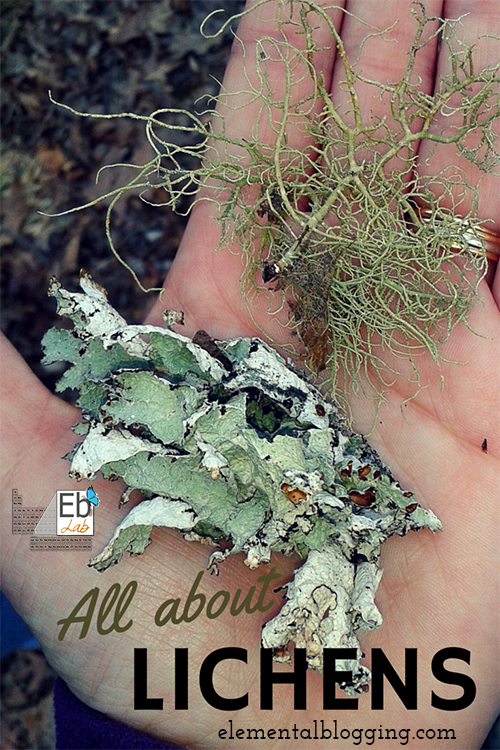 Lichens are perfect to study around this time of year. As the trees are shedding their leaves and the plants are starting to die off, the lichens in the area begin to stand out.
Lichens are perfect to study around this time of year. As the trees are shedding their leaves and the plants are starting to die off, the lichens in the area begin to stand out.
Lichens can be found all over the world, including the in the desert! Typically, you will find them on the bark of a tree or on a rock. Many lichens are about the size of a human fist, but they can grow to be as large as dinner plates and even larger!
In this week’s homeschool science corner we are going to take a look at the amazing lichen!
What are lichens?
Lichens are the result of a symbiotic, or mutually beneficial, partnership between a fungus and an alga plant or a bacterium. In other words, they are technically not plants, but rather a living partnership.
In the lichen partnership the fungi protect the algae or bacteria that live below. In turn, the algae or bacteria provide the fungi with the sugars they need to grow.
Lichens reproduce through the use of diaspores, which are released into the air. The diaspore is simply a spore with some additional tissue. Lichen diaspores contain spores from the fungus plus a few cells from the alga or bacterium. Once the diaspora lands in a suitable place, it grows and develops into another lichen.
As I said before lichens are found through the world, growing on tree trunks and rocks. Lichens can be found in some of the harshest environments, such as the arctic tundra.
Three Different Types of Lichens

There are three main types of lichens:
- Fruticose – These lichens are shrub-like. (pictured on the left)
- Foliose – These lichens are more leaf-like. (pictured in the center)
- Crustose – These lichens are flat and crusty. (pictured on the right)
The crustose lichen is generally the most commonly recognized type. But, the three different types of lichens can all be found in most environments.
Lichens Hunt
So now that your students understand a bit more about the amazing lichen, it is time to take them on a lichen hunt!
You will need a magnifying glass and a putty knife for your hunt. Begin by taking the students for a walk around your house or in your local woods to look for examples of lichens on trees and rocks.
After they find a lichen, ask them these questions to help their observations:
- Where do the lichens grow (i.e. full sun, partially shade, or dark)?
- What do the lichens grow on (i.e. rocks, ground, or glass)?
- What type of lichens did you find?
Have the students observe the lichen with their magnifying glass to see how it is different or similar to other plants they have observed. Once they have look the the lichen up close, scrape off a tiny bit of the lichen with the putty knife. Have the students turn it over and examine the underside.
If possible, have the students look for all three types of lichens. Have them observe each one in the same way, noting any similarities and/or differences.
In a Nutshell
Lichens are the result of an amazing biological partnership. They are a fascinating living example of symbiosis perfect for a fall study.
Here is a narration sheet you can use with your students as you discuss the lichens with them.
I trust that you and your student will enjoy exploring the wonderful world of lichens!
 Sign up below to receive weekly tips & tools for homeschool science and we'll send you a FREE copy of
Sign up below to receive weekly tips & tools for homeschool science and we'll send you a FREE copy of 
I love lichens! (I think that one simple statement probably speaks volumes about me!) Thanks for reminding us that this is still a lot to explore out there on the trees even after the leaves have fallen. I’ve been finding a lot of oak ball galls too- that is a fun one to learn about as well.
I agree, Sarah! Lichens are amazingly beautiful when you really take the time to look at them. Oak ball galls are interesting subjects to study too during this time of the year. Bravo to you for seizing the science-learning moment :-).